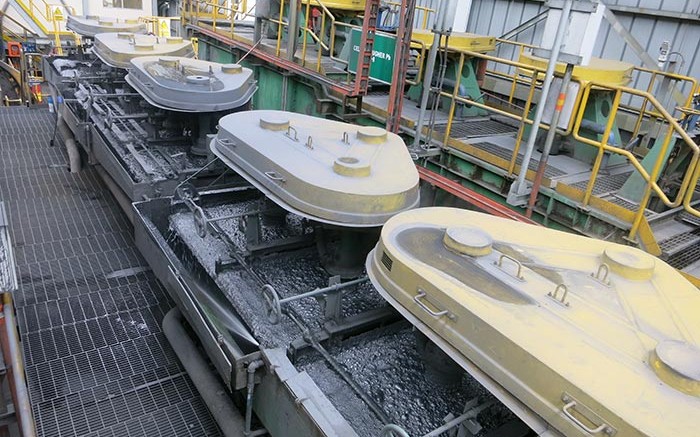The following is an edited summary from the Silver Institute, based on findings in its World Silver Survey 2018. For more information, visit www.silverinstitute.org.
Industrial demand for silver, fuelled by record photovoltaic growth, rose in 2017 for the first time since 2013. A stronger global economy led to healthy demand from the semi-conductor market, resulting in greater silver offtake in electrical and electronics applications, as well as brazing alloys and solders. The jewellery and silverware sectors also saw gains in 2017. On the supply side, global mine supply fell for the second straight year, after an uninterrupted streak of 13 annual increases before 2016. Silver scrap supply, which has retreated since 2012, again registered a loss. This led to a tightening of the supply and demand balance, contributing to a physical deficit of 26 million oz. in 2017, the fifth consecutive annual deficit.
Industrial demand
Global silver industrial fabrication demand returned to growth in 2017, increasing 4% to 599 million ounces. This was the first rise in silver industrial fabrication since 2013. This growth was bolstered by another year of impressive photovoltaic demand, rising 19% in 2017, the result of a 24% increase in global solar panel installations. Brazing alloy and solder silver fabrication recorded a 4% annual rise to 57.5 million oz., boosted by solid growth from China and Japan.
The surge in electronics — especially semi-conductor fabrication demand — led to the electrical and electronics segments delivering the first annual offtake increase in this category since 2010, with 242.9 million oz. consumed last year. Silver demand for ethylene oxide production retreated one-third from 2016 volumes to 6.9 million oz., mostly due to a decline in new installations. Silver’s use in photography, which fell 3% last year to 44 million oz., appears to have stabilized, with renewed interest in various photographic applications using silver, only falling marginally over the last few years.
Jewellery and silverware
Silver jewellery demand moved 2% higher in 2017 to 209.1 million ounces. India was chiefly responsible for the gain, rising 7% over 2016 volumes. Demand also picked up in North America, with the U.S. posting a 12% rise to an all-time high. Global demand for silverware jumped 12% last year to 58.4 million oz., led by a strong recovery in demand from India, which saw a 19% increase. North America also posted solid gains, rising 5% to 1.6 million ounces.
Supply
Global silver mine production fell 4.1% in 2017, experiencing its second consecutive annual decline to record 852.1 million ounces. The decline came after a series of supply disruptions across the Americas. Another factor in the drop owed to primary silver and gold sectors, where production fell a combined 29.4 million ounces. Of the key producing countries, Peru and China registered subtle dips, followed by more acute losses in Australia and Argentina. Offsetting those losses was higher output from Mexico, which was once again the world’s top silver-producing country, trailed by Peru, China, Russia and Chile.
Supply from primary silver mines decreased 9% in 2017 to contribute 28% of total mine supply. The lead and zinc sector contributed 36% of by-product output, followed by copper at 23% and gold at 12%.
Silver scrap supply fell to 138.1 million oz., marking its sixth straight yearly decline. Lower scrap flows from Asia — mainly China — driven by a lack of incentives from both suppliers and consumers to recycle their valuables, is chiefly responsible for the fall. Supply from the western world was marginally higher, driven by increased volumes from the United States and Europe.
Above-ground stocks rose 3% last year. Of the four exchanges that report silver stocks, three saw 2% total silver inventory growth in 2017 — Comex in the U.S., and the Shanghai Futures Exchange and Shanghai Gold Exchange in China. In contrast, silver inventories held at Tokyo Commodity Exchange declined a dramatic 98%, driven by strong industrial demand in Japan.
GFMS reports that government sales of silver were once again absent from the silver market in 2017. Lastly, in the supply category, the delta-adjusted hedge book inched higher by 1.4 million oz., ending last year at 21.5 million ounces.
Price and investment
The annual average silver price fell a slight 0.5% to US$17.05 per oz. last year, with prices trading in a US$15.22 to US$18.56 per oz. range. That said, last year’s average silver price represents an 8.7% increase over the average posted just two years ago of US$15.68 per ounce.
Identifiable investment, which consists of net-physical bar investment, coins and medals purchased, and net changes to exchange-traded product (ETP) holdings, reached 153.5 million oz. in 2017 — a 40% decline from the previous year. This was primarily the result of a 35% decline in coin and medal fabrication, led by lower demand in the U.S., Canada and China. Physical bar demand slipped 16% last year.
In contrast, total global ETP holdings increased 2.4 million oz. to finish 2017 at 669.8 million ounces. In value terms, total ETP holdings increased 4% to US$11.3 billion, as the silver price advanced throughout the year.




Be the first to comment on "Facts ‘n’ Figures: Silver industrial demand rebounded in 2017"